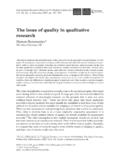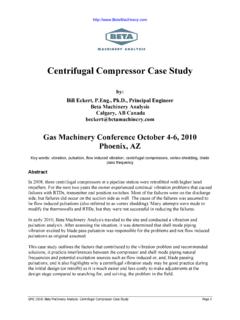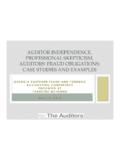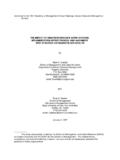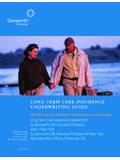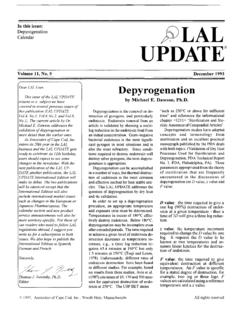Transcription of EJM Research design and data analysis in realism research
1 Research design and dataanalysis in realism researchRana SobhDepartment of Marketing, University of Auckland, Auckland, New Zealand, andChad PerryDepartment of Marketing and Management, Southern Cross University,Gold Coast, AustraliaAbstractPurpose The aim of this paper is to apply principles of the realism paradigm within qualitativeresearch The paper starts by establishing the usefulness of realismresearch for investigating marketing management phenomena, and then considers the implications ofthe realism paradigm for Research Issues such as the level of prior theory required, the use of replication logic andtriangulation are discussed. In addition, guidelines for realism data analysis and reporting This paper provides an explicit set of principles for realism Research design anddata analysis that is different from those in other types of , design , Data analysisPaper typeConceptual paperIntroductionMany researchers are concerned with the choice between a quantitative and aqualitative methodology.
2 Essentially, quantitative researchers use numbers and largesamples to test theories, and qualitative researchers use words and meanings insmaller samples to build theories (for example, Easterby-Smithet al., 1991). Someresearchers use only one type of methodology while others suggest that both typesmay sometimes be appropriate (Borch and Arthur, 1995; Hyde, 2000), even though thetwo methods may produce contradictory findings about the same phenomena, or atleast unrelated ones it is likely that quantitative methods and qualitative methodswill eventually answer questions that do not easily come together to provide a single,well-integrated picture of the situation (Patton, 1990, pp. 464-5).However, a core issue for researchers is not related to choice of methodologies butrelated to acknowledgement of the Research paradigms. A methodology is only one ofthe three elements of a paradigm that researchers either explicitly or implicitly workwithin a paradigm includes the other elements of ontology and epistemology (Gubaand Lincoln, 1994).
3 Essentially, ontology is reality , epistemology is the relationshipbetween that reality and the researcher, and methodology is the techniques used by theresearcher to discover that reality. In brief, a paradigm is an overall conceptualframework within which a researcher may work, that is, a paradigm can be regardedas the basic belief system or worldview that guides the investigator (Guba andLincoln, 1994, p. 105). Philosophical assumptions that support four different paradigmsThe current issue and full text archive of this journal is available ,11/121194 Received February 2005 Revised August 2005and September 2005 European Journal of MarketingVol. 40 No. 11/12, 2006pp. 1194-1209qEmerald Group Publishing Limited0309-0566 DOI science positivism, realism , constructivism and critical theory are summarisedin Table these four paradigms is the question of knowledge creation: how can thefindings of one Research project be generalised to other situations?
4 In the first of thefour paradigms, positivism, knowledge is statistically generalised to a population bystatistical analysis of observations about an easily accessible reality. In the secondparadigm of realism , the findings of one study are extended by analyticalgeneralisation that shows how the empirical findings of a Research project nestlewithin theories (ontology cells, Table I). In other words, the aim of realism paradigm isto generalise to theoretical propositions and not to populations (Yin, 1989, p. 21). In theother two paradigms of constructivism and critical theory, reality is perception andso generalisation of one Research finding about someone s perceptions to anotherperson s theory about reality, cannot be done. For example, in constructivism,findings are related to individual views of the world and create a world of multipleconstructed realities. Such views cannot be usefully compared with those of otherParadigmElementPositivismConstructi vismCritical theoryRealismOntologyReality is real andapprehensibleMultiple local andspecific constructed realities Virtual realityshaped by social,economic, ethnic,political, cultural,and gender values,crystallised overtimeReality is real butonly imperfectlyandprobabilisticallyapprehens ible andso triangulationfrom many sourcesis required to try toknow itEpistemologyFindings true researcher isobjective byviewing realitythrough a one-waymirror Created findings researcher is a passionateparticipant withinthe world beinginvestigatedValue mediatedfindings researcher is a transformativeintellectual whochanges the socialworld within whichparticipants liveFindings probablytrue researcher isvalue-aware andneeds to triangulateany perceptions heor she is collectingCommonmethodologiesMostly concernswith a testing oftheory.
5 Thusmainly quantitativemethods such as:survey,experiments, andverification ofhypothesesIn-depthunstructuredintervie ws,participantobservation, actionresearch, andgrounded theoryresearchAction Research andparticipantobservationMainly qualitativemethods such ascase studies andconvergentinterviewsNote:Essentially, ontology is reality , epistemology is the relationship between that reality and theresearcher and methodology is the technique used by the researcher to discover that realitySource:Based on Perryet al.(1999), which itself was based on Guba and Lincoln (1994) from whichthe quotations comeTable scientific paradigmsResearch designand dataanalysis1195individuals (as in post-modern Research ) (Bazeley, 2004). Similarly, in the critical theoryparadigm, perceptions are judged by their appropriateness to subjective conventionssuch as beauty and justice (as in feminist Research ) (Perryet al., 1999).Of the four paradigms, this paper will focus on marketing knowledge creationwithin the realism paradigm.
6 In contrast to this paradigm, the positivism paradigmposition on knowledge creation about an easily apprehensible reality throughvalue-free procedures is well known, although it may often be inappropriate forreasons developed in the next section. In addition, constructivism and critical theoryresearch will not be covered in detail here because they are explicit or implicit in muchqualitative Research literature. Their assumption that reality is a subjectiveconstruction is sometimes inappropriate for marketing management for reasonsdiscussed in the next the aim of this paper is to explain how realism Research can be designed tobuild knowledge about the external reality of marketing. Essentially, we argue thatworking within the realism paradigm requires procedures that are different fromprocedures in positivism, constructivism and critical theory paradigm Research . Inparticular, procedures relating Research design and about data analysis and reportingrequire explicit acknowledgment, although none appear to exist.
7 Our contribution istherefore explicit sets of principles for realism Research design and data analysis thatare different from other types of addressing this aim, this article concentrates on Research design and dataanalysis. Other issues in realism Research , for example, arguments about philosophicaldetails (Hunt, 1994; Zinkhan and Hirscheim, 1992) or how to judge the quality ofrealism Research (Healy and Perry, 2000; Thompson and Perry, 2004) have been dealtwith article has four sections. We begin with a brief introduction to realism s coreideas and compare them to those of the other three paradigms. Then Research designbuilding on prior theory and using replication logic in realism Research is , appropriate analysis and reportage techniques in realism Research are paradigmBefore examining realism Research design , its particular appropriateness for muchmarketing Research needs to be establishedvis-a`-visother Research done within otherparadigms.
8 In essence, a paradigm reflects a researcher s understanding of the natureof existence that is beyond logical debate because each paradigm is rational withinits own constructed logic (Lincoln and Guba, 1985). That is, there is no objective ground for choosing a paradigm. All that one can do is work within a paradigm that isconsistent with a researcher s own presumptions, presumptions that cannot be testedon any empirical or logical grounds. Thus assumptions behind some paradigms needto be discussed first, to try to determine how closely or not they fit the perceivedvalues and needs of the stakeholders of Research first, positivism paradigm is the most widely used paradigm for businessschool Research (Orlikowski and Baroudi, 1991) and assumes implicitly or explicitlythat reality can be measured by viewing it through a one way, value-free mirror (thisdiscussion of paradigms is based on Perry (2002). Engineers, for example, use theseassumptions to Research a physical science phenomenon like a bridge.)
9 This receivedEJM40,11/121196view (Guba and Lincoln, 1994, p. 106) of science has dominated the formal discourse inthe physical and social science for some 400 , the positivism paradigm has been criticised for its exclusion of thediscovery dimensions in inquiry and the under-determination of theory (Deshpande,1983; Guba and Lincoln, 1994). For example, the assumptions of positivism notedabove are appropriate in a physical science such as zoology, but may be inappropriatewhen approaching a complex social science phenomenon, which involves reflectivehumans, such as , some Research has shown that these almost default assumptions ofbusiness school Research are sometimes inappropriate for Research about social sciencephenomena like marketing and management. Consider some of this Research in , replication of positivism Research does not usually produce the same results asthe prior Research , as one would expect from the value-free methods of positivismresearch about an easily apprehensible reality.
10 Hubbard and Armstrong (1994) foundthat only 15 percent of replication studies in the social science of marketing fullyconfirmed the prior findings and only 25 percent partially confirmed them. Indeed,fully 60 percent of replication studies provided results that conflicted with theirpredecessor. Of those few studies that support prior Research , over half were done bythe same researcher as did the prior Research (Hubbard and Vetter, 1996), confirmingthat the Research did not appear to be done in the value-free way that , meta-analyses of several positivism studies often confirm this picture of theinadequacy of positivism for investigations of social phenomena. A meta-analysiscompares several quantitative studies on a common scale. For example, thecorrelations over many studies between customer satisfaction and these constructscover a wide range of values that even spread across positive and negative values(Szymanski and Henard, 2001).
